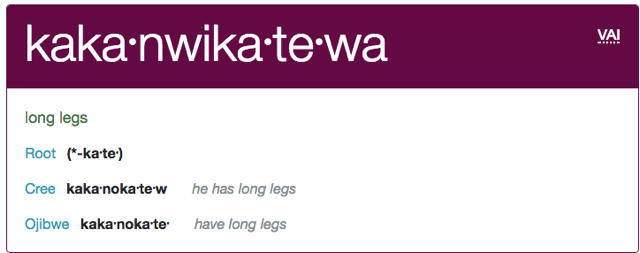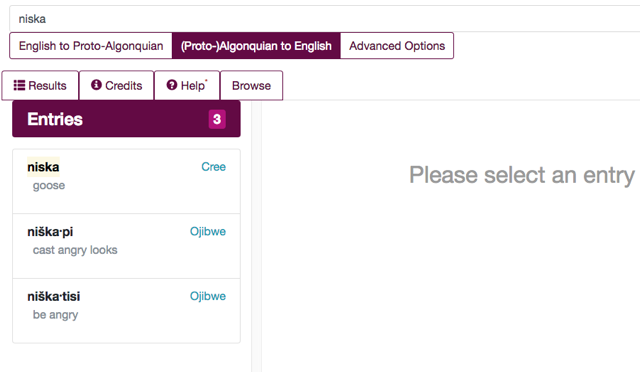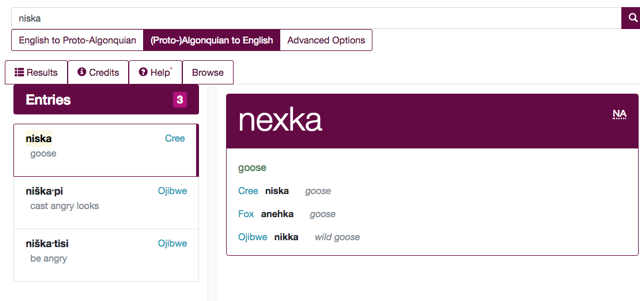How to use the online dictionary:
- Type what you are looking for in the search box
- Choose:
- English to Proto-Algonquian if the text typed is in English
- (Proto-)Algonquian to English if the text typed is in any Algonquian languages
- Advanced Options to modify the search process and results
- Click on the to perform the search
Browse gives you the option to browse the entire dictionary either by part of speech, or by PA entries.
The search in English gives you Proto-Algonquian (PA) results only, with each entry showing the full English translation as well as each subentry in the various languages used for reconstructing it, when available. These daughter languages examples are called “cognates”.
Usually PA forms would be preceded by an asterisk (*) to indicate reconstruction, but we did not add * in front of all the PA entries. You should add it when you cite a PA form. For example, the PA entry below should be cited as: *kakaᐧniwikaᐧteᐧwa.
However, * appear in front of so-called “Roots” (also in brackets) inside the entries, in order to clearly differentiate between attested daughter languages forms (cognates) and PA forms.

The search in (Proto-)Algonquian looks in both Proto-Algonquian and just Algonquian, including the cognates. For example, if you search Cree niska, you will find all entries containing niska, and once you select an entry, you will see the full PA entry with the cognates under it. Notice how the search ignores diacritics to give you maximal results.


The default search is “beginning with…”. Advanced Options allow you to restrict the search to other parts of the words or to whole words. It also allows you to search roots.
You can search long vowels by typing double vowels (aa, ee, ii, oo, uu) or hats (â, ê, î, ô, û) or macrons (ā, ē, ī, ō, ū).

Note:
This proto-algonquian dictionary is the result of a historical reconstruction of over 4 000 vocabulary items using a methodology described in the following publications:
Hewson, John. 2001. The comparative method applied to Amerindian: the reconstruction of Proto-Algonkian. In History of the Language Sciences, eds Sylvain Auroux, E.F.K. Koener, Hans-Joseph Niederehe & Kees Veersteegh: Vol. 2:1384-1391. Berlin & New York: Walter de Gruyter.
Hewson, John. 2010. Sound change and the comparative method: the science of historical reconstruction. In The Continuum Companion to Historical Linguistics, eds Silvia Luraghi & Vit Bubenik, pp. 39-51. London & New York: Continuum.
This dictionary was initially published as a book in 1993. Typos and other minor errors in the database were corrected between 2015 and 2017 with the author to prepare this online version. Other (pdf) documents on Roots and Formatives are available here…
Book reference :
John Hewson. 1993. A computer-generated dictionary of proto-Algonquian. Gatineau – Quebec : National Museums of Canada. 281 p. ISBN : 0-660-14011-X

